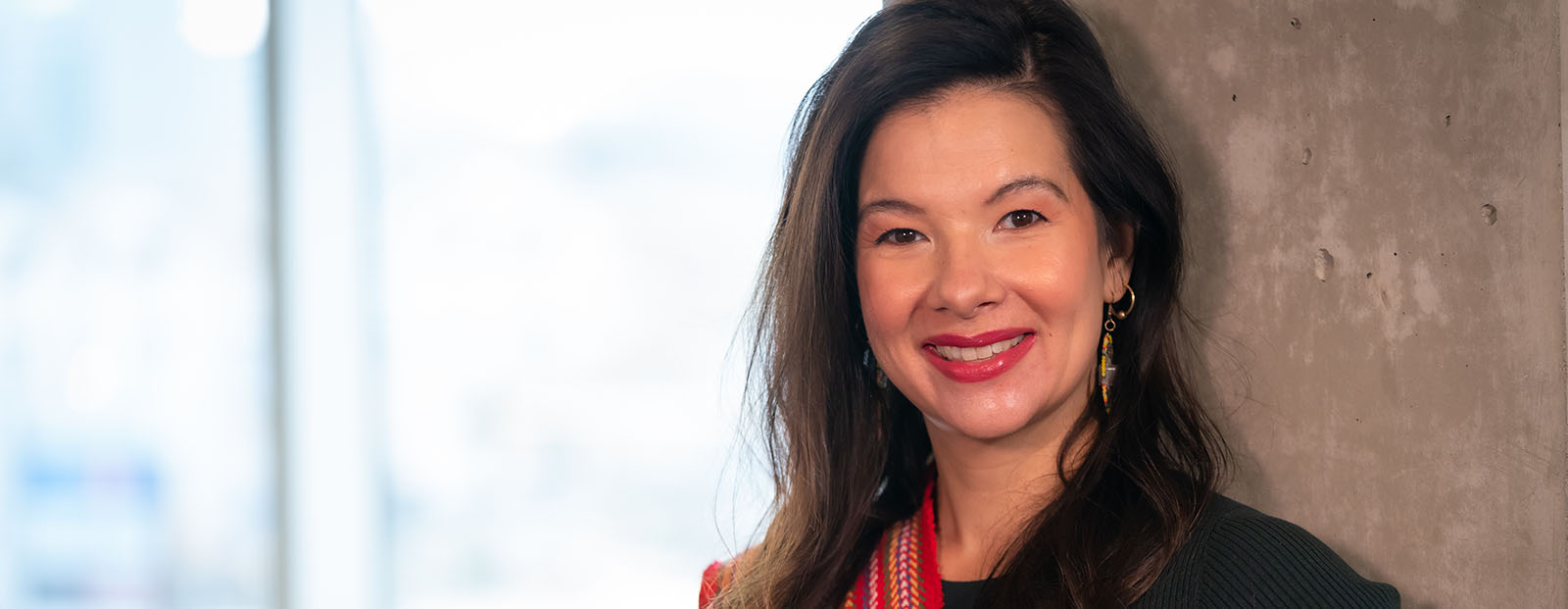Shelby LaFramboise describes her tenure-track cross-appointment between an academic department in a faculty or school and kihêw waciston Indigenous Centre, the first of its kind at MacEwan, as a "multiplicity of roles." She is developing and delivering some of the university's first Indigenous courses and creating a safe space to encourage her faculty colleagues, staff and students to make change.
“The nature of Professor LaFramboise’s appointment – having one hand in an academic department and one hand in kihêw waciston – is unique, but we hope it also sends a very clear message about our commitment to reconciliation,” says Dr. Craig Monk, provost and vice-president, Academic. “Our plan is to continue to hire more colleagues with this kind of appointment, so that the benefit of a dual approach threads its way across the university.”
LaFramboise divides her time between helping kihêw waciston with its work and programming and teaching, developing curriculum and sharing her Indigenous perspective within the Faculty of Fine Arts and Communications.
“Connecting is, by far, one of the best pieces of this work,” says LaFramboise. “I hope to provide cultural safety for staff and faculty and students to feel grounded in Indigenous pedagogy, ideology and way of life. To walk alongside each other and be curious – to be open participants who can question, query, be honest and sometimes be angry. I think that’s a beautiful way to create change that moves us forward.”
In the Winter 2022 term, LaFramboise piloted the first offering of INTA 362: First Peoples and the Arts, which focuses on Indigenous arts advocacy and is part of the university’s new Bachelor of Fine Arts program. Throughout the term, she invited Indigenous artists and Elders into the class to share their perspectives on the arts.
Elder Francis Whiskeyjack set the tone with an explanation of his view of the arts as a lived journey embedded into every part of his life. MacEwan alum Leanne Goose (Arts and Cultural Management ’17) shared a Northern perspective and her journey through the arts as a performer and arts facilitator committed to creating equitable access. Artist, writer and researcher Lana Whiskeyjack shared her women’s teachings. Métis artist Angela Hall offered her perspective on trauma and trauma healing through painting and poetry. And Cynthia Jim focused on song and story, sharing a dance that honoured Missing and Murdered Indigenous Women and Men.
“I wanted students to see in each of these very powerful experiences the sovereignty that Indigenous people from many nations are ultimately living through the arts, and how advocacy is a way of holding space for that sovereignty,” says LaFramboise. “I hope that we were able to create a safe space for them to feel something deeply – a ricochet or spark – that interrupted their ideas of learning.”
That interruption made this course unique – and challenging.
“They were all completely receptive to the process,” she says. “This way of learning is not linear or outcomes-based, which our entire K to 12 system of public education is based on. I was reminded recently by an Elder that this work is really about putting spirit back into curriculum.”
That unlearning, and ultimately relearning, through a paradigm that is not necessarily inherently their own, says LaFramboise, can be uncomfortable and requires vulnerability from both the learners and the artists.
“Repeatedly, students expressed through journaling the vulnerability of the artists to share their deepest, most personal experiences with complete and utter strangers. It resonated with students because they realized that the artists were saying that we're all connected; we're all related. That we are brothers and sisters.”
Over the past year, LaFramboise also supported opportunities for faculty and staff in the Faculty of Fine Arts and Communications to reconnect with the land and move toward Indigenization.
“It’s really important to get people on the land – not only to re-story amiskwaciy-wâskahikan, the Edmonton area, but to re-story how we see land,” she says. “During those experiences, when we embrace the land as teacher and healer, we can have the deep, meaningful conversations we need to ultimately put the Spirit back into what we are facilitating and teaching.”
Taking those first steps – literally and figuratively – is something LaFramboise says can not wait.
“The time for waiting is over. We don't need to wait for our syllabi to change. We don’t need to wait for policy to change. We can do the work right now. We can take current and contemporary events and embed them naturally within our courses. We can invite Indigenous artists, writers, storytellers, massage therapists, police officers, nurses, journalists – people who have lived experience and can lend their Indigenous voice to what we are teaching.”
In addition to her work in the Faculty of Fine Arts and Communications, LaFramboise’s work with kihêw waciston involves developing another new course focused on Indian Residential Schools.
“I know that I hold a lot of responsibility in this work, but I also know that I have 1,000 ancestors guiding me, and I appreciate that. I’m one of the voices speaking out for all of the times they weren’t heard. I’m part of the legacy of what they prayed for.”
